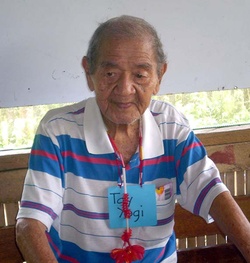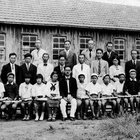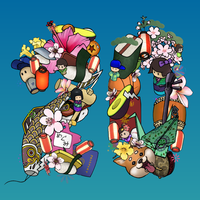"I bumped into this person out of nowhere in the mountains of Mindanao, and he said to me in Japanese, 'I'm Ainoko.' I was so surprised."
YA, a Japanese businessman living in Davao, Philippines, talks about his sudden encounter with a Japanese-Filipino named Mr. A. At the time, he was a journalist and was tracking the activities of guerrillas such as the New People's Army (NPA) in the mountainous region of Mindanao. That was the first time that YA learned of the existence of Japanese-Filipinos.
Davao is the third largest city in the Republic of the Philippines, located on the island of Mindanao. It is the political and economic center of the southern Philippines, and a base for tourists heading to nearby resorts. At the beginning of the 20th century, Japanese immigrant workers led by Kyozaburo Ota came here and developed abaca (Manila hemp) cultivation. In 1940, just before the Pacific War, there were about 20,000 Japanese residents. It formed the largest Japanese community in the Southern Ocean, and is said to have had 13 Japanese elementary schools (Amano, 1990, p.64; Kojima, 1999, p.181). The stories of the unimaginable hardships of Japanese immigrants in Davao and their children during the war have been depicted in many documentaries1. For the first-hand testimonies of immigrants who returned to Japan after the war, please refer to the Okinawa Prefecture municipal histories such as Kin Town History and Ginoza Village History.
This year, in February 2011, I visited Davao. As a special edition of "Japanese Education Across the Sea," I would like to introduce just one aspect of the history of Japanese education in the Philippines, which unfolded in parallel with that in Brazil, through the experiences of the Japanese people of Davao that I was able to come into contact with.
Immigrants who worked in hemp cultivation in Davao first had to endure many years of hard labor (Amano, 1990, pp.32-38). Eventually, those who endured acquired land and built families. Once they had a certain amount of economic security, they began to think about educating their children as "Japanese", and this is the same in Brazil and the Philippines. Here too, "immigrants were enthusiastic about education." In 1924, about 20 years after Ota and his group settled in Davao, the Davao Japanese Elementary School opened in the city, and the Mintal Japanese Elementary School opened in the suburbs.
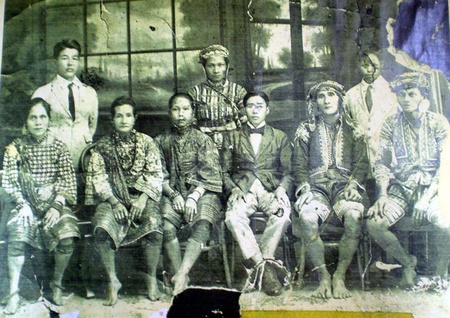
Bonus 1-1: The wedding of the parents of Ms. M's siblings. Many single Japanese immigrants married women from local tribes such as the Bagobo and built families (Provided by YM)
"The immigrants were enthusiastic about education. They seemed to strongly want their children to receive a Japanese education and to go on to junior high school and girls' school. The Mintal Elementary School in the Philippines that I attended had two classes, one for first and second grade and one for third and fourth grade, which were combined classes. There were students from Kin Town as well as Yamato people. A local female teacher taught English from the first grade onwards." (Kin Town History Compilation Committee, 1996, p.112) This is the testimony of a child of immigrants who studied at Mintal Elementary School.
During one day in Davao, I visited Mr. MY at the Los Amigos nursing home, about an hour's drive from Davao City, accompanied by Mr. YA and Mr. S from the local Japanese Chamber of Commerce and Industry. Mr. MY is disabled and uses a wheelchair, but when I asked him his date of birth, he answered in clear Japanese, "I was born on February 29, 1932" (Photo 1-2). His father was from Motobu Village, Okinawa, and his mother was a local Bagobo tribe.
"My father was strict with discipline. When I got up early in the morning, I would say, 'Good morning,' bow and slowly raise my head. When I was going to school, I would say, 'I'm off now,' and my father would say, 'Go.' If I spoke to my siblings in Filipino, he would say, 'Speak Japanese,' and beat me. If we misbehaved, we would be thrown from the second floor. My mother would sometimes get beaten as well."
"The distance from my house in Baguio to school was about six kilometers. I walked there with the older kids from the neighborhood. On rainy days, I would use potato leaves as an umbrella because I would get in trouble for cutting abaca leaves. I didn't wear shoes, I walked barefoot. I would hit rocks many times and my toenails would come off, which was painful."
They walk barefoot for kilometers. There are no paved roads, so on sunny days it's dusty, and on rainy days it's muddy. They walk soaking wet, using large leaves as umbrellas. But they're all pretty much the same, so there's no sense of poverty. This is a common scene on the way to school for immigrant children in rural Brazil. As Mr. A mentioned earlier, there were many mixed-race children, which is different from Brazil and the United States. In Amano's book mentioned above, mixed-race children are called "kuronbo" (black boy) or "native," and there is a description of bullying among children, but MY says, "I don't remember being bullied (because I'm mixed-race)." The relationships (power relationships) among children are just as delicate and complex as those of adults.
When asked what he liked and disliked about school, MY repeatedly said, "I liked that they were strict (at school). Because they were strict, I didn't become a bad kid."
On another day, I visited Toril, where Japanese people were detained after the war. AT-san, who still lives in Toril, was born in 1931 and is 79 years old. He spoke Japanese well, having worked as an interpreter for memorial groups coming from Japan.
"At that time, I was living in Balakatan, and there was no school in the mountains (hemp farm), so I went to the boarding school at Davao Elementary School. My father was from Uto, Yatsushiro County, Kumamoto Prefecture. He was a strict man and always said, 'School is the most important thing.' So I never missed school. My younger brother and sister were attacked by a horse on the way (to school) and couldn't go to school. When we got home, we had a call from the school. My father was angry and wouldn't let us in the house even at night. My mother? She was very kind. But I always listened to what my father said, saying 'yes, yes.'"
"When I entered the fifth grade, I was transferred to Categan Primary School, which was closer to home. I could see my mother every day and this primary school was better. The school was about seven kilometers from my house. I left at 5am and always made it just in time."
"I loved sewing. But I left my beautiful, favorite sewing kit in my desk, and that night the war started and the Japanese were rounded up (internment camps). I left my sewing kit there. It was only when the Japanese army landed in January (1942) that we were finally liberated."
The tragedies of Japanese people and their families around the time of the US invasion in April 1945 have been revealed in many testimonies. AT's family also experienced this hellish evacuation, losing their father and younger brother. The youngest brother's name was "Yoshikatsu." "He was born when the Japanese army came to help us. He died when Japan lost," AT said solemnly, but I had no words to answer. AT now runs a kindergarten with her daughters in the town where they were interned.
In the village of Cullinan, we interviewed the three siblings of Mr. M's family. All three appear to have almost forgotten Japanese. When we couldn't communicate, Professor I from Mindanao International University accompanied us and translated in a mixture of English and Visayan. There used to be a Japanese school in Subasta, where the M's family lived. The eldest brother, KM, who is in Japan, went to primary school in Cullinan, but the eldest sister, TM, and the fourth son, SM, went to a new primary school in Subasta2 . The children were "all Japanese," and the teacher was a man named Yoshida.
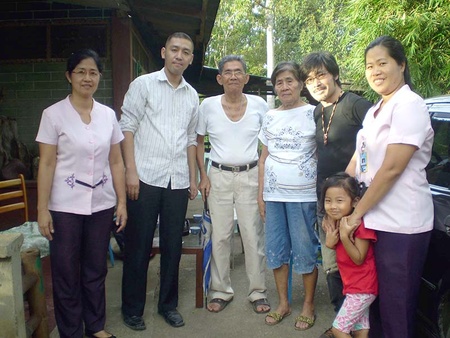
Bonus 1-3: Mr. M's family, from left: Mr. TM's daughter, Professor IM, Mr. YM, Mr. TM, the author, and Mr. TM's grandson (photographed by the author in February 2011)
The elementary school in Subasta was built by the father of Mr. M and his siblings, who raised money. The youngest brother, YM, tells the story of how the school was built:
"First we go to the poorest Japanese and ask them how much they can give, then we get everyone's signatures. Then we call in the lumberjacks and start building the school. Then everyone has no choice but to give money."
The story conveys the image of a hand-built school on the front lines of development during wartime. There were about 30 children, so it was a fairly large school. According to Kobayashi (2010), around 1943, when military rule was established in the Davao region, education for the children of Japanese immigrants was positioned as part of the construction of the Greater East Asia Co-Prosperity Sphere, and the content of education changed (pp. 289-296). Even at this school in the mountains, they would pay homage to the Imperial Palace every Sunday morning and recite the Imperial Rescript on Education. However, despite the effort of building the school, guerrillas came when TM was in the second grade, and the children stopped attending (because they were scared).
After this conversation, I asked TM, "Do you remember anything? Anything is fine." She seemed troubled and kept saying "I forgot," but suddenly, as if she had made up her mind, she started singing, "The sun sets with a slight glow, and the bells of the temple in the mountains ring." Teacher I, who loves music, took over and continued, "Hold hands," and I quickly joined in, singing, "Let's all go home." Finally, YM, TM's daughter, and grandchild joined in, and we all sang together, "Let's go home together, crows." It was a slightly off-key chorus, but for a moment the wall that separated the Philippines and Japan, 70 years ago and the present, crumbled, and it was a heartwarming chorus in which everyone became children again and sang with all their hearts. It was a moment when I felt, "These people are definitely Japanese children" (Photo 1-3).
As dusk approached the village of Cullinan, we decided to head back to the city of Davao (photo extra 1-4). Davao, Philippines - just like Brazil, here too there was a history of immigrants who lived in a parallel era to modern Japan.
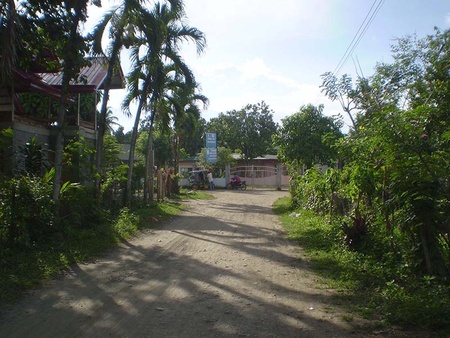
Bonus 1-4: The Cullinan alley at dusk. I wonder if the singing voices of Japanese children once echoed through the streets. (Photo by author, February 2011)
Note
1. Shibata (1979), Shirota (1980), Amano (1990), Ohno (1991), Maruyama (2008), etc.
2. The name of this Japanese elementary school in Subasa does not appear among the 13 schools in the Davao region mentioned above. According to Shirota (1980), "there were 12 elementary schools for Japanese living overseas" that "continued classes during the war, but in 1944, as air raids by American military aircraft became more severe, each school was forced to split up classes" (p. 193), and it seems that several "schools" were open in various places.
References
Amano, Yoichi (1990), Descendants of the Kingdom of Davao: Abandoned Japanese in the Philippines, Fumaidashisha Ohno, Shun (1991), Hapon: The Long Postwar Life of Japanese in the Philippines, Daisan Shokan Kin Town History Editorial Committee (1996), Kin Town History, Vol. 1 (Immigrants and Testimonies), Kin Town Board of Education Kojima, Masaru (1999), Research on Japanese Schools: A Study of the History of Intercultural Education, Tamagawa University Press Kobayashi, Shigeko (2010), The Path of Immigrants: A History of Education in Okinawa and the Philippines, Gakubunsha Shibata, Kenichi (1979), Davao War Chronicles: The Glory and Tragedy of the South Seas Development, Tairiku Shobo Shirota, Yoshiroku (1980), The Glory and Failure of Davao Immigrants: From the Notes of Japanese Residents, Nagasaki Publishing Bunka Kyokai Maruyama, Chuji (2008), My Father Who Disappeared in Davao, Fumaidashisha
[Acknowledgements] This Davao survey was made possible through the support of the National Institutes for the Humanities' "Research Study of Japan-related Materials Overseas." While in Davao, we received assistance from Mr. Kazumichi Miyake of Mindanao International University, Mr. Yoichi Amano and Mr. Sumikawa of the Japanese Chamber of Commerce and Industry in Mindanao, and Ms. Nelma Saito of the Davao Japanese Association. Furthermore, in writing this article, Mr. Atsushi Sasaki, who lives in Miyagi Prefecture, kindly provided us with many materials. In addition to the informants introduced in the text, many other people also cooperated with interviews. We would like to take this opportunity to express our sincere gratitude to them all.
© 2011 Sachio Negawa


